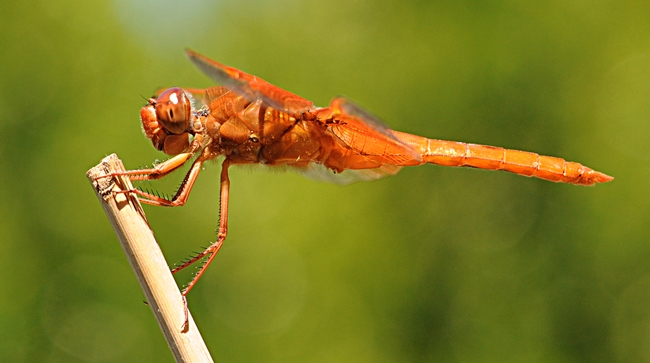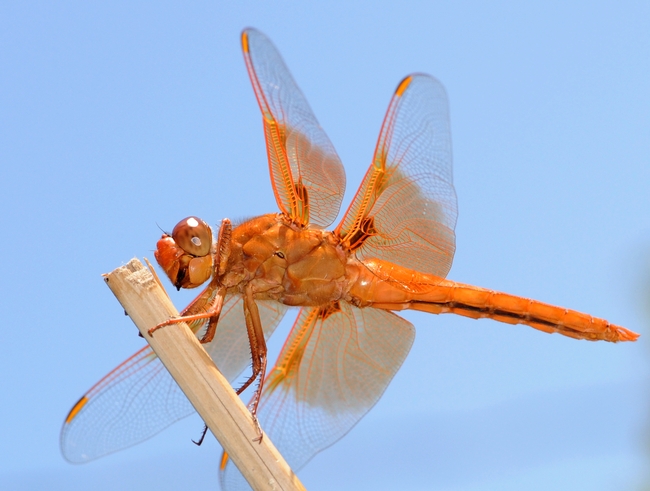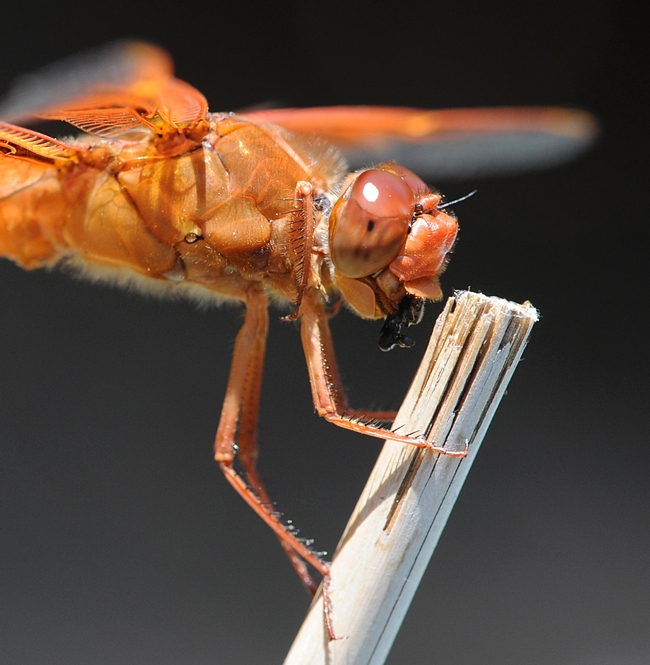- Author: Kathy Keatley Garvey
Don't you just love those dragonflies?
We watch them circle our fish pond, grab flying insects in mid-air, and then touch down on a bamboo stake in our yard to eat them. Some dragonflies stay for hours; others for what seems like half a second. Some let you walk up to them and touch them. Others are so skittish that they must have once encountered a nasty predator with a bad attitude and a big appetite unfulfilled.
We've observed several different species in our yard (thanks to naturalist Greg Kareofelas of Davis, volunteer at the Bohart Museum of Entomology, University of California, Davis, for identifying the Sympetrums and the "widow skimmer," Libellula luctosa).
The ones we've photographed:
- Red flame skimmer or firecracker skimmer (Libellula saturata), a common dragonfly of the family Libellulidae, native to western North America.
- Variegated meadowhawk (Sympetrum corruptum), a dragonfly of the family Libellulidae, native to North America.
- Widow skimmer (Libellula luctuosa), part of the King Skimmers group of dragonflies that are found throughout much of the United States, except in John Denver territory (The Rockies). You can find them in parts of Canada, including southern Ontario and Quebec.
- Red-veined meadowhawk (Sympetrium madidum), found throughout much of the United States (Alaska, California, Colorado, Iowa, Idaho, Missouri, Montana, Nebraska, North Dakota, Oregon, Washington and Wyoming) and much of Canada (Alberta, British Columbia, Manitoba, Northwest Territories, Nunavut, Saskatchewan and Yukon)
Can you believe dragonflies were some of the first winged insects that evolved 300 millions years ago? And that the order they belong to, Odonata, means "toothed one" in Greek?
Can you believe that globally, we have more than 5,000 known species of dragonflies?
Can you believe that dragonflies eat only the prey they catch in mid-air? And that they grab them with their feet? Umm, dead bee on the ground? No, thanks!
Can you believe that dragonfly called the globe skinner has the longest migration of any insect—11,000 miles back and forth across the Indian Ocean?
For those and other interesting facts, be sure to read Sarah Zielinski's "14 fun facts about dragonflies" published Oct. 5, 2011 in smithsonian.com
For a close look at some of the Bohart Museum's collection of dragonflies, you can visit the insect museum, located in Room 1124 of the Academic Surge building on Crocker Lane, from Monday through Thursday, 9 a.m. noon, and from noon to 5 p.m. (excluding holidays). Admission is free. You can even buy dragonfly-related items in the gift shop. That would include posters (the work of Greg Kareofelas and Fran Keller) and jewelry.
The Bohart Museum, directed by Lynn Kimsey, professor of entomology at UC Davis, houses nearly eight million insect specimens. And not just dragonflies, bees and butterflies. There are critters you've never seen before. And some, such as the Xerces butterfly (Glaucopsyche xerces), are extinct.
The Bohart's next weekend open house, the last of the 2013-2014 academic year, is Saturday, July 26 from 1 to 4 p.m. The theme focuses on spiders: "Arachnids: Awesome or Awful?" It's family-oriented and free and open to the public. (For more information contact Tabatha Yang, education and outreach coordinator, at tabyang@ucdavis.edu).

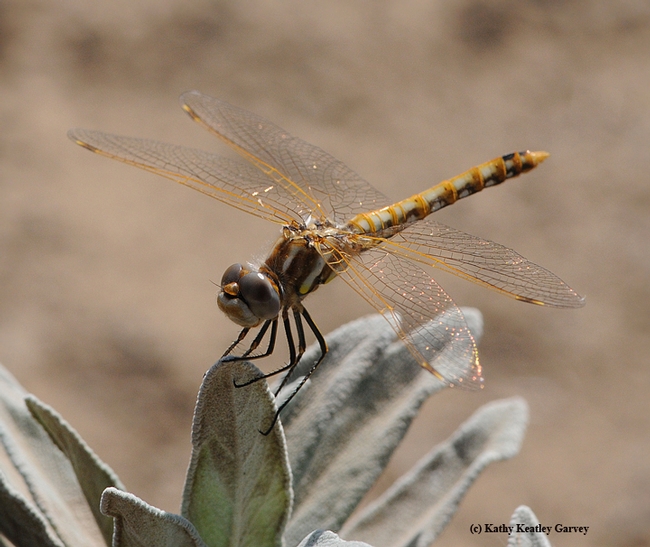

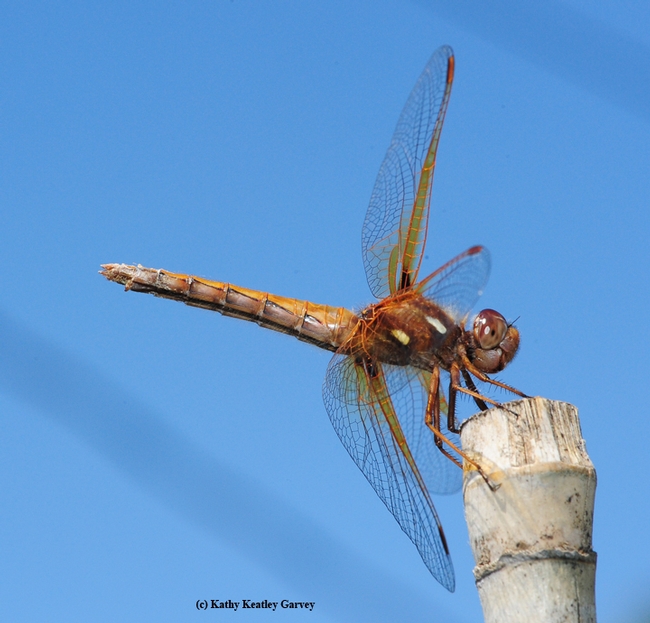
- Author: Kathy Keatley Garvey
Of the many things I'm thankful for on this Thanksgiving Day, I am thankful for the millions of insects that populate our planet. Scientists have described more than a million species, but there may be 10 million more undescribed.
I am thankful for honey bees. There is no more comforting sound on a warm summer day than the buzz of bees as they pollinate the plants and return to their colonies with nectar and pollen. I am thankful for their role in providing the fruits and vegetables that we eat.
But that's just me.
I am thankful for bumble bees, especially the endangered ones that struggle to overcome the tragic changes to their environment. Bumble bees are social insects but what developers and others are doing to them is definitely anti-social.
But that's just me.
I am thankful for butterflies, nature's flying art that flutter in our garden and touch gently down on blossoms for a lingering sip of nectar. Their beauty overwhelms me.
But that's just me.
I am thankful for the pre-historic looking dragonflies that glide gracefully over our ponds and streams to snag mosquitoes and other undeirable insects.
But that's just me.
I am thankful for the insects that clothe us: the bees for pollinating cotton plants, and the silkworms for spinning cocoons.
But that's just me.
I am thankful for the beneficial insects, like honey bees, ladybugs, lacewings, assassin bugs, damsel bugs, soldier beetles, big-eyed bugs, syrphids, and parasitic mini-wasps.
But that's just me.
I am thankful for bee gardens, gardeners, entomologists and insect photographers. Frankly, I would rather spend an afternoon photographing insects in my backyard than sitting on a crowded beach in Hawaii with a little umbrella decorating a drink that I don't drink.
But that's just me.
I am thankful I don't engage in recreational shopping, collect pretentious possessions, or focus on five-star restaurants, especially when starving, ravaged and troubled souls sit forlornly outside. I firmly believe that Brown Thursday, Black Friday and Cyber Monday should not be an integral part of our lives, and that “greed” should be replaced by “giving."
But that's just me.
I'm happy with what I have. To me, it's important to “want” what you have, than to “have” what you want.
But that's just me.
Today I'm especially thankful for two Gulf Fritillary butterflies that just emerged from their chrysalids.
The double emergence may seem like a “minor” thing to be thankful for today but it's the “minor" things that I treasure. And why "happy" should always precede the name of this holiday.
"THANKS...
GIVING."



- Author: Kathy Keatley Garvey
It's a bird, it's a plane...
It's not Superman. It's a flame skimmer dragonfly (Libellula saturata).
We spotted this dragonfly in our yard recently and crouched down for a low angle, framing it against the sky.
This is one insect that everyone notices and admires.
Except maybe its prey...
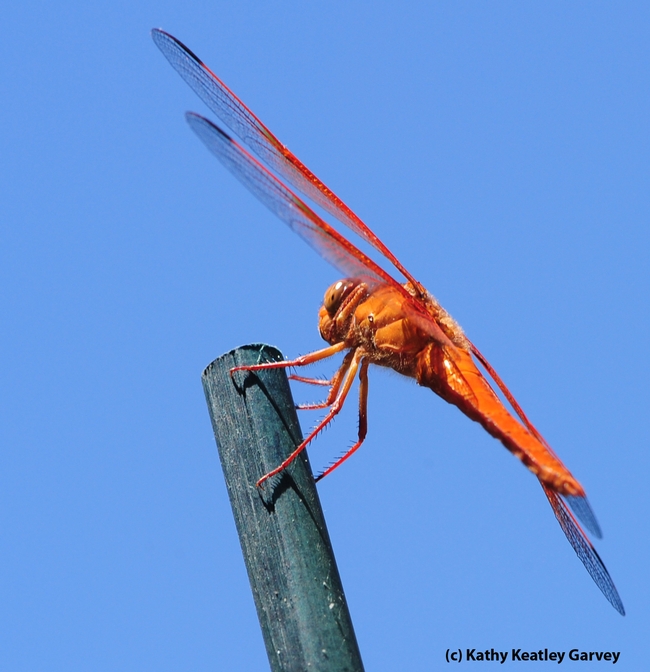
- Author: Kathy Keatley Garvey

It's a joy to watch these firecracker-red dragonflies (Libellula saturata) make their presence known. They dart over our fish pond, snatch an insect, and then perch on a tomato-plant stake to eat it.
Last year another generation did the same thing. They darted over our fish pond, snatched an insect, and then staked their claim in the vegetable garden. Over a tomato plant.
Most of the time the flame skimmers seem unaware of my presence. Guess they consider me neither prey nor predator.
If you love dragonflies, several years ago the Bohart Museum of Entomology, University of California, Davis, created an educational poster, "Dragonflies of California," the work of doctoral candidate Fran Keller and naturalist/photographer Greg Kareofelas of Davis. It focuses on 18 dragonflies commonly found in the Golden State. The largest insect depicted in the poster is the Giant Darner (Anax walshinghami), but the most colorful just has to be...drum roll...the flame skimmer. But I'm biased.
Keller came up with these facts about dragonflies:
Ten fast facts about dragonflies, as provided by the Bohart Museum:
- Dragonflies date back before the dinosaur age.
- The largest known prehistoric species of dragonfly, living 300 million years ago, was the Meganeura monyi. Its wingspan measured more than two feet long.
- The largest species today is a South American dragonfly with a wingspan of 7.5 inches. The smallest modern species is an east Asian dragonfly, the libellulid dragonfly, Nannophya pygmaea, with a wingspan of about 3/4 of an inch.
- California is home to approximately 108 species. More than 5000 species are found worldwide.
- Dragonflies help control pests such as mosquitoes, midges and flies, but will also dine on honey bees and butterflies.
- The adults feed by hawking their prey. They dart off a perch to catch prey and often return to the perch to eat.
- Most dragonflies live around lakes, ponds, streams, and marshes; their larvae, known as “nymphs,” are aquatic. Some dragonfly larvae live in bromeliad flowers.
- Dragonflies usually do not bite or sting humans, but if grasped by the abdomen, they may bite to escape.
- The dragonfly is thought to have better eyesight than any other insect. Its compound eyes take up much of the insect’s head. Each compound eye has up to 30,000 facets or sensor modules, arranged to provide nearly a 360-degree field of vision. That's why it's difficult to sneak up on them.
- Dragonflies are a common motif in Native American art, displayed on Zuni pottery, Hopi rock art and on Pueblo necklaces. In Japan, they are considered symbols of courage, strength and happiness.
The Bohart Museum, home of more than seven million insects, is open year around, but is closed to the public on Friday. It's directed by Lynn Kimsey, professor of entomology att UC Davis.
But if you want to see dragonflies in The Great Outdoors, look for them near a body of water, whether it be a river, creek or...a fish pond in the back yard...
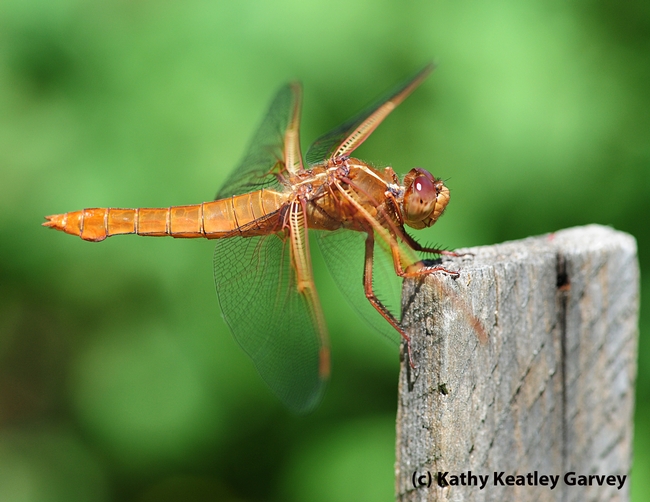

- Author: Kathy Keatley Garvey
For at least three days, he visited our yard.
He swooped over our fish pond and swimming pool and returned each time to perch on a tomato stake in the vegetable garden.
We nicknamed him "Big Red." Big Red? Actually, a flame skimmer dragonfly (Libellula saturata), native to western North America.
Our presence never bothered him. Our excitement at seeing him never bothered him. My macro lens poked a couple of inches from his face never bothered him.
I captured his image from above (bird's eye view), from the sides (both sides now!) and from beneath (bug's eye view).
No worries.
It was only when I popped a barbell-like ring flash on the 105 macro lens that he stirred. Whoops! That was a bit big. He lazily took off and then returned--with a native bee in his mouth.
One day Big Red sat on his perch for three hours, periodically leaving to snag insects, then methodically returning to eat them.
On the fourth day, he disappeared. We haven't seen him since.
I suspect Big Red proved to be an easy catch for a hungry bluejay.
